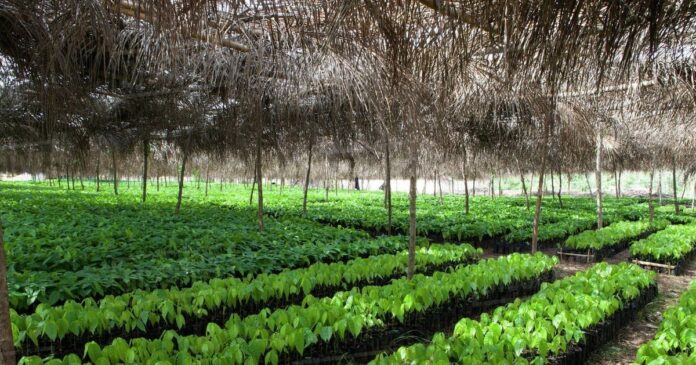The success of a cocoa farm to a larger extent will depend on a good planting material. You can grow your cocoa farm from the seed (directly) or seedling. We recommend you do it with the cocoa seedlings from a good cocoa nursery establishment.
What is a cocoa nursery?
The cocoa nursery is where you raise cocoa seedlings for transplanting to the field at the appropriate time. The work on cocoa nursery should start somewhere between November and December. This timing will help you meet the rains at the time of transplanting to the field.
Read also: Vegetable Seedling Nursery Establishment and Management
Site selection for cocoa nursery establishment
Make the following considerations when you are thinking of a place to establish your nursery.
- Water. The nursery will require water and especially in the period you will be doing it. So make sure there is an available and accessible water source.
- Select a flat land, preferably close to the farm on which they will be transplanted.
- The soil must have good drainage. Water-logging is not good for your nursery.
- The site for your nursery should be away (about 10meters) from the nearest cocoa farm. Pest from these cocoa farms can also attack the seedlings.
- Some shady trees may pose a problem for the nursery and may even promote the infection of Cocoa Swollen Shoot Virus Disease (CSSVD).
Read also: Site Selection for Farming Purposes: 7 Very Key Factors to Consider
Land preparation and shading of the cocoa nursery site
You must weed and clear the site of all obstacles that will impede work in the nursery.
Cocoa nursery establishment requires that you erect a temporal shade with shade nets or palm fronds. This is to protect the seedlings from direct sunlight. Raise the shade about 2meters above the ground.
If there is livestock around that could pose threat to the seedlings, fence it.
Nursing the cocoa
You can raise the cocoa seedling in;
- Pots / Polythene bags
- Seedbed
Raising cocoa seedlings in pots/polythene bags
1. Get your polythene bags
a. If you are nursing the cocoa for a shorter period, say 3months, the bags can be smaller in size (about 12.5 cm x 25 cm)
b. If you are nursing for up to 6 months use a much bigger polythene bag (18cm x 25cm)
2. Create drainage holes at the bottom of the polythene bags. This will allow excess water to drain off and prevent logging.
3. The you fill poly bags with soil to the brim. Use soils with good aeration, water retention and high in organic matter.
4. For easy management, arrange the bags in a block. Let each row have 10bags wide and 100bags longs. That will be 1000bags per block.
5. To make movement easy through the blocks, leave a gap of about 45-60cm. This will be used as path during the various operations on the nursery.
6. Water the soil in the bags before sowing the cocoa beans.
7. Sow the bean at a depth of 2cm with the pointed side of the bean upward. If you are not sure, place it flat at the same depth. Avoid seeds that are already germinating.
8. Monitor germination and growth.
Cocoa nursery establishment on nursery beds
1. Weed and clear the area of all plant debris.
2. Prepare your bed of about 12.5cm high and 120cm wide. The length could go as you want. However, leave a gap of about 45-60cm to serve a path. This will help avoid stepping on the bed and compacting it during various operations in the nursery.
3. Level the top of the beds and create grooves 20cm apart on the entire bed.
4. Now, place the cocoa beans in the grooves 10cm apart.
5. Provide shade as it is done in the polythene bags method.
Note: Do not keep seedlings for more than 4months before transplanting when you raise them on beds.
How to maintain the cocoa nursery
After germination, watering should be done in the morning and evening when it is not raining. This will not be the case in the rainy season. Water as and when it is required. Too much watering can cause damping-off.
Control weeds regularly on polythene bags or nursery bed by hand.
Applying fertilizer or manure
Little or no fertilization may be needed if good soils are used in the cocoa nursery establishment.
However, if they are lacking in nutrients you can apply the recommended rate of fertilizer a month after germination. Be careful, if granules are used they don’t fall on the leaves. They can scorch the leaves. Water well so that the granular fertilizer can dissolve for the roots to use.
Read also: Why is Organic Fertilizer Better?
Controlling pest and disease
Use the recommended fungicides and insecticides to control pests and diseases. Do not apply those chemicals with knapsack sprayers used for applying herbicides.
Hardening the seedlings
Hardening helps to prepare the seedlings for transplant to their permanent field.
This is done by reducing the shade gradually a month before transplanting. The shade is then removed completely a week to transplanting.
At this stage, reduce watering and do not apply fertilizer.
Transporting seedlings from nursery to the field
This is a critical stage after the cocoa nursery establishment. The seedlings if not well handled can be damaged during transport.
Do not overcrowd the seedlings. Carry just as much as the space available.
Records keeping on cocoa nursery establishment.
Read also: Importance of Farm Records Keeping for Efficient Farm Management
This activity should be done at the beginning, during and at the end of the nursery establishment. Keep records on everything including the source and quantity of materials used, the number of seeds planted, the number of seeds germinated, etc.


